Biofuels for use in road transport
Overview
Contents
- Post-2020 Visions and National Plans for Sustainable Transport
- SPM7 presentation on the role of advanced biofuels in future transport options
- SPM6 presentation on Fuel and technology alternatives for commercial vehicles
- Overview on current status of road transport in Europe, alternative fuels and future perspectives for biofuels
- Passenger transport by road
- Freight road transport
- EC activities on sustainable road transport
- Links, reports and references
Post-2020 Visions and National Plans for Sustainable Transport
In December 2015, ECN published a report, comissioned by EBTP, on Post-2020 Visions and National Plans for Sustainable Transport. The EBTP has also produced a draft Position Paper on Post-2020 Transport Strategies in Europe, focusing on the pivotal role of advanced biofuels in national and European transport strategy.
A key message of the EBTP position paper is that "Next to RD&D and innovation support, a clear EU obligation for advanced biofuels is required. Such an obligation should be gradually increased in the period from 2021 to 2030. The obligation can be defined as an absolute amount e.g. in terms of energy or greenhouse gas reduction, or as a relative share of biofuels in transport energy demand or liquid/gaseous transport fuels demand, and it can be applied to Member States or to fuel blenders."
Key findings of the ECN report were as follows:
- In all Member States, ambitions beyond 2020 are still in the phase of visions and plans, and have not yet been translated into formal legislation.
- Not all the Member States have issued national plans beyond 2020. Only Finland, Germany, the Netherlands, Poland, and the UK have issued national plans in this regard.
- Timeframes and horizons regarding the action plans for sustainable transport are diverse among Member States. These vary from 2020 and up to 2050.
- There is a major difference in the availability of data among national plans, which diverges between qualitative and quantitative data. Moreover, a major difference among the national plans is found with regards to the level of in-depth data.
- The status of the policy documents varies from: visions, targets and national strategies.
- The aim of the policy documents varies from one Member States to another, according to their national preferences. For some Member States the aim is to modernize or update the transport system, while for others the aim is to decarbonize the system or lower the emissions related to transport.
SPM7 presentation on the role of advanced biofuels in future transport options
Presentation made at EBTP SPM7, June 2016, by Nils-Olof Nylund, EBTP Working Group Chair ‘End use and distribution’, VTT on The role of advanced biofuels in future transport options.
Summary
- Deep decarbonisation of transport will require a wide range of measures
- One single energy carrier cannot meet all needs:
- It is not electric vehicles vs. biofuels
- It is both electric vehicles and biofuels!
- Biofuels can serve all modes of transport, road, rail, marine and air
- The automotive manufacturers are now starting to see the value of high quality fungible biofuels
- At least until 2030, biofuels seem to be more cost effective than electrification in reducing GHG emissions
- Advanced biofuels can offer a fast track to decarbonisation
SPM6 presentation on fuel and technology alternatives for commercial vehicles
Presentation made at EBTP SPM6, October 2014, by Nils-Olof Nylund, VTT on Fuel and technology alternatives for commercial vehicles.
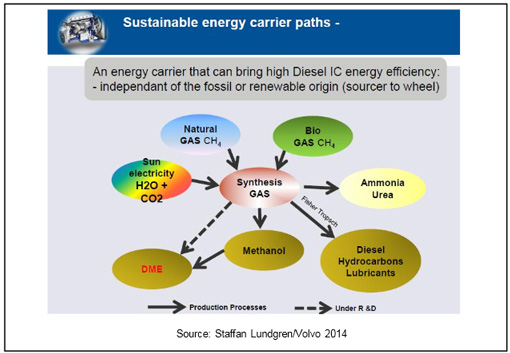
Overview
Current status
 In 2010 the worldwide annual road energy consumption was 1,698 Mtoe – the largest consumers were the USA with 30 %, EU-28 with 18 % and China with 8 %. The forecast is that while the US and EU-28 will be able to reduce their road energy consumption by 2050, China and India will become the largest consumers (AMF 2012).
In 2010 the worldwide annual road energy consumption was 1,698 Mtoe – the largest consumers were the USA with 30 %, EU-28 with 18 % and China with 8 %. The forecast is that while the US and EU-28 will be able to reduce their road energy consumption by 2050, China and India will become the largest consumers (AMF 2012).
Final energy consumption in EU road transportation with 297.6 Mtoe in 2011 takes a share of 81.7 % of final energy consumption of the transport sector. Road transport accounts for the greatest amount of energy consumption in transport. 95.3 % of this energy comes from petroleum products, and only 4.7 % from biofuels (EC 2013).
Therefore road transport needs major "de-carbonizing" actions. There is no single fuel solution for the future of mobility - all main alternative fuel options must be pursued, from liquid and gaseous biofuels to electricity.
Road transportation can be divided into passengers and goods transport in the EU. In 2011 the passenger vehicle stock was 278 Mio. with 5,334 billion pkm in the EU Member States and the goods vehicle stock was 34 Mio. with 1,734 billion tkm. The majority of intra-EU passenger transport (83 %) is accounted for by road transport, whereas 43 % of freight transport is by road (EC 2013).
Alternative fuels for road transport
In the EU, road transport biofuels account for 4.7 % (13,985 ktoe) of final energy consumption, divided into biodiesel (10,644 ktoe), biogasoline (2,892 ktoe) and other liquid biofuels (422 ktoe) (EC 2013). Biofuels are largely compatible with today’s engines and vehicles and can be blended with current fossil fuels to a certain extent. Figure 1 shows the main alternative fuels and their possible coverage for road transportation in different travel ranges.
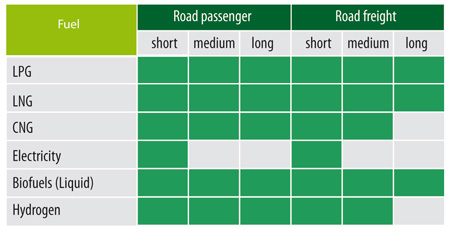
Figure 1: Coverage of transport modes and travel range by the main alternative fuels (COM (2013) 17)
For road transport, the most promising biofuels are liquid and drop-in biofuels, such as B7, E10, E20, lignocellulosic drop-in gasoline and diesel and HVO/CHVO as well as PPO/SVO (Pure Plant Oil/ Straight Vegetable Oil), used in fleets. Conventional bioethanol and biodiesel are commercially available across all Member States of the EC, and are widely used in fuel blends for passenger and freight vehicles on Europe’s roads.
The most suitable biofuel-vehicle components for a liquid biofuel strategy to 2030 and beyond are depicted in figure 2. More information on the respective advanced biofuels can be found in the value chains section.
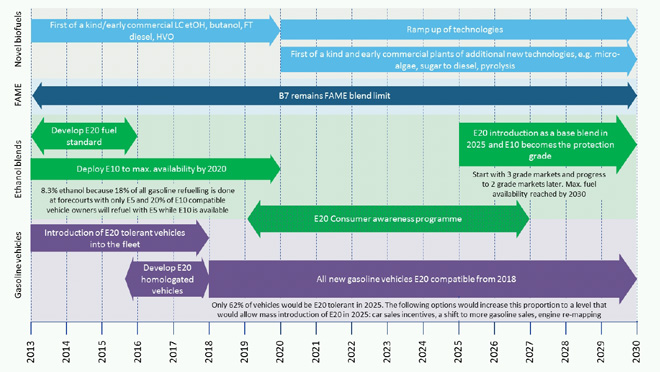
Figure 2: Components of a harmonised Auto-Fuel biofuel roadmap for the EU to 2030 (E4Tech 2013)
View image at larger size
Future perspectives for biofuels in road transport
The promotion of biofuels is a political priority and part of the European energy-climate policy. The EC Directive 2009/28/EC on the promotion of the use of energy from renewable sources introduced a binding target of 10 % share of renewable energy in transport by 2020. For this target, biofuels will make a substantial contribution. In addition, Directive 2009/30/EC allows for the blending of ethanol into petrol up to 10 % (v/v) and for a FAME content of 7 % (v/v) in diesel.
In 2013, the European Parliament stated its intention to place a 6 % cap on first-generation biofuels and a 2.5 % incorporation threshold of advanced biofuels, produced from waste or algae, but these initial ambitions were cut down in the draft directive on the change of land use (June 2014). This agreement imposes a minimum level of 7 % of final energy consumption in transport in 2020 for first-generation biofuels and does not provide for a binding incorporation target for advanced second and third generation biofuels. The agreement is still in a draft version, a final decision is expected for 2015 (EurObserv’ER 2014).
Future expansion of biofuels in road transport up to 2020 and beyond depends on a favourable regulatory environment for advanced biofuels value chains, in particular to support:
- availability of more diverse feedstocks including energy crops, wastes and residues
- demonstration of innovative thermochemical, biochemical and chemical conversion technologies at commercial scale
- market development of advanced biofuels through support mechanisms at national and EC level
Global expansion of biofuels use in road transport also depends on the ongoing development of:
- CI and DI engines able to use higher blends of ethanol and diesel
- the development of drop-in biofuels with properties 'near-identical' to their fossil fuel counterparts. Drop-in fuels can be used in standard engines at much higher blend levels than conventional biofuels, or even at 100% with similar performance.
Passenger Transport by Road
 Since 2010, 842 Mio. passenger light-duty vehicles (passenger cars) have been on the road worldwide. EU-28 countries hold 28 % of the world’s passenger vehicle stock, the US holds 25 % and Japan, Korea, China and India hold together 16 % (AMF 2012). In 2011 the EU passenger vehicle stock was 242 Mio. passenger cars (483 cars/ 1000 inhabitants), 820,000 buses and coaches and 34 Mio. powered two-wheelers (EC 2013).
Since 2010, 842 Mio. passenger light-duty vehicles (passenger cars) have been on the road worldwide. EU-28 countries hold 28 % of the world’s passenger vehicle stock, the US holds 25 % and Japan, Korea, China and India hold together 16 % (AMF 2012). In 2011 the EU passenger vehicle stock was 242 Mio. passenger cars (483 cars/ 1000 inhabitants), 820,000 buses and coaches and 34 Mio. powered two-wheelers (EC 2013).
In 2011, total passenger transport activities in the EU (including intra-EU air and sea transport) are estimated to have amounted to 6,569 billion pkm. The data for the different passenger transport modes for 1995-2011 is depicted in figure 3. 83.1 % of this amount came from passenger road transportation. Passenger road transportation can be divided into cars (light duty vehicles), buses and coaches (heavy duty vehicles) and powered two-wheelers. The main part of road passenger transportation is done with light duty vehicles (88.4 %; 4,822 billion pkm); buses and coaches (9.4 %, 512 billion pkm) and powered two-wheelers (2.3 %, 123 billion pkm) play a secondary role (EC 2013).
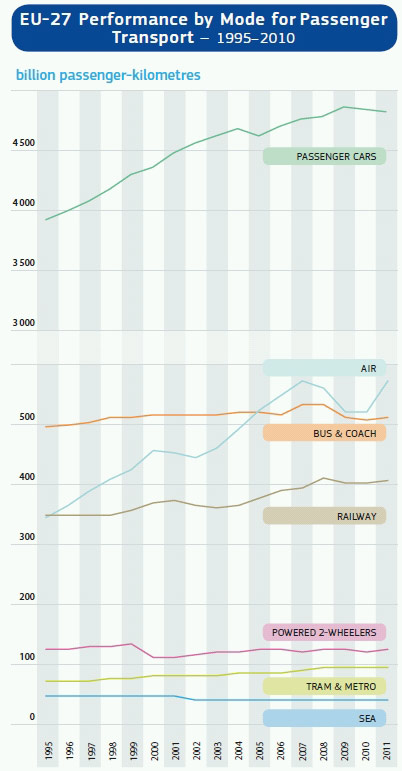
Passenger transport by mode (EU27 as in 2010, prior to advent of EU28)
Freight road transport
The vehicle stock for commercial freight vehicles in the EU is much lower than for passenger transportation, in 2011 34 Mio. commercial freight vehicles were on the road.
In 2011, total goods transport activities in the EU (including intra-EU air and sea transport) are estimated to have amounted to 3,824 billion tkm. The distribution of goods transports to the respective transport modes is given in figure 4. Road transport accounted for 45.3 % (1,734 billion tkm), followed by intra-EU maritime transport with 36.8 %. Rail transport accounted for 11 %, inland waterways for 3.7 % and oil pipelines for 3.1 %. Intra-EU air transport only accounted for 0.1 % of the total.
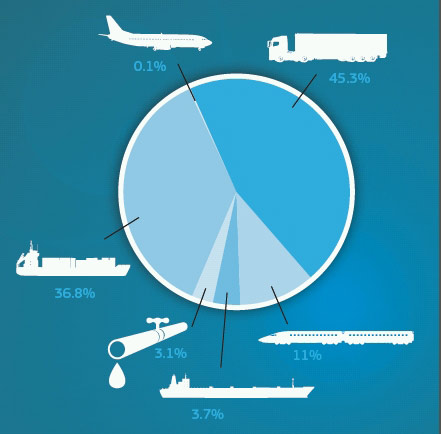
Figure 4: Freight transport in %, based on tkm (EC 2013)
Also, in future freight transport over short and medium distances (below some 300 km) will, to a considerable extent, remain via trucks and heavy duty vehicles. Besides encouraging alternative transport solutions (rail, waterborne transport), it is therefore important to improve truck efficiency. This can be done via the development and the uptake of new engines and cleaner fuels, the use of intelligent transport systems and further measures to enhance market mechanisms.
EC activities on sustainable road transport
It is recognised that liquid transport fuels from renewable sources are just one aspect of the transition to a more sustainable transport system. On 24th January 2013 the EC published COM(2013) 17 Clean Power for Transport: A European Alternative Fuels Strategy, which encompasses Biofuels as well as LNG, SNG, electricity and hydrogen. See also the Press Release Europe Launches Clean Fuel Strategy
Under Horizon2020, R&D&D relating to advanced biofuels is included within the Secure, Clean and Efficient Energy work programme. Wider sustainable transport R&D (including gas and hybrid/electric road vehicles) is covered by the Smart, green and integrated transport work programme.
Following the introduction of the directive on the promotion of clean and energy efficient vehicles, the EC launched a Clean Vehicle Portal to advise buyers (domestic and public and private fleet managers) on the environmentasl impact of all new vehicles. This takes into account energy consumption, CO2 emissions and pollutant emissions over the lifetime of each vehicle (from manufacture to disposal). The website also includes useful information on procurement rules and incentive schemes for clean vehicles and EU-wide information about market-shares of clean vehicles.
The Clean Urban Transport pages on the EC Mobility and Transport website discuss recent policy, reports and research in this area.
The 'Transport GHG: Routes to 2050?' project, commissioned by DG Climate Action, has now entered it's second phase and will continue to develop an understanding of potential impacts of transport GHG reduction policies, and evaulate various potential pathways. Project reports and the SULTAN illustrative scenarios tool, which was developed as part of the project, are also available on the website.
As part of the Commission's modern industrial policy, the CARS 21 (Competitive Automotive Regulatory System for the 21st century) process, which was initially launched in 2005, aims to make recommendations for the short-, medium-, and long-term public policy and regulatory framework of the European automotive industry. This framework enhances global competitiveness and employment, while sustaining further progress in safety and environmental performance at a price affordable to the consumer. Among other topics, CARS 21 addresses alternative fuels.
Links, reports and references
- CARS 21 (Competitive Automotive Regulatory System for the 21st century)
- Clean Urban Transport page on the EC Mobility and Transport website
- COM (2011) 144: White paper – Roadmap to a Single European Transport Area – Towards a competitive and resource efficient transport system
- COM (2013) 17: Clean Power for Transport: A European alternative fuels strategy
- Directive 2009/33/EC of the European Parliament and of the Council of 23 April 2009 on the promotion of clean and energy-efficient road transport vehicles
- ERTRAC 2009: ERTRAC Road Transport Scenario 2030+
- Climate and Clean Air Coalition CCAC
- COM (2013) 17: Clean Power for Transport: A European alternative fuels strategy
- Directive 2009/28/EC: Directive 2009/28/EC of the European Parliament and of the Council of 23 April 2009 on the promotion of the use of energy from renewable sources and amending and subsequently repealing Directives 2001/77/EC and 2003/30/EC
- Directive 2009/30/EC: Directive 2009/30/EC of the European Parliament and of the Council of 23 April 2009 amending Directive 98/70/EC as regards the specification of petrol, diesel and gas-oil and introducing a mechanism to monitor and reduce greenhouse gas emissions and amending Council Directive 1999/32/EC as regards the specification of fuel used by inland waterway vessels and repealing Directive 93/12/EEC
- A harmonized Auto-Fuel biofuel roadmap for the EU to 2030, E4tech (UK) Ltd
- EU transport in figures – statistical pocketbook 2013, EC 2013
- EurObserv’ER Biofuels Barometer
- IEA-AMF 2012: IEA Advanced Motor Fuels – Annual Report 2012
- Report of the European Expert Group on Future Transport Fuels
- ERTRAC Road Transport Scenario 2030+
- Reducing Transport Greenhouse Gas Emmissions - Trends and data 2010 (OECD)
Previous EU-funded research and resources on use of biofuels in road transport
The following EU-funded projects cover R&D on biofuel end use in road transport (a more comprehensive list of related biofuels R&D projects are included on the funding page):
TRIP - Transport Research and Innovation Portal. TRIP is the hub for European transport research and innovation.
BEAUTY - Bio-ethanol engine for advanced urban transport by light commercial & heavy-duty captive fleets (DG Research)
BEST - BioEthanol for Sustainable Transport
OPTFUEL - Optimised fuels for sustainable transport (paving the way for large scale BtL production).
RENEW- Renewable Biofuels for Advanced Powertrains
2NDVEGOIL - Demonstration of 2nd generation vegetable oil fuels in advanced engines
